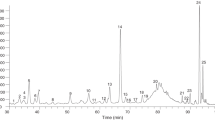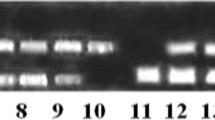Abstract
This study reports for the first-time antioxidant activity and flavonoid composition of KP onion landrace which is useful for future breeding programs and to obtain geographical indication (GI) tag for the benefit of farmers. The present study was aimed to determine antioxidant capacity and flavonoid composition of bulbs of red onion (Allium cepa L.) landrace ‘Krishnapuram’ (KP) from India using high-performance liquid chromatography (HPLC)-Electrospray Ionization (ESI)-multistage Ion Trap Mass Spectrometry (ITMS). The antioxidant activity was assayed by Ferric Reducing Antioxidant Power (FRAP) and hypochlorous acid (HClO)-induced oxidative damage in human erythrocytes. The total phenolic (TPC) contents in KP onion bulb extract (with 80% methanol) found to be 1.10 ± 0.2 mg GAE/g FW and 38.88 ± 1.0 µM QE/g. The FRAP activity measured for the bulb extract was 13.20 ± 0.1 µM QE/g. KP onion bulb extracts protected red blood cells (RBC) effectively (23%) against the oxidative damage induced by HClO. HPLC-ESI-ITMS analysis showed the presence of eight flavonols and five anthocyanins. Quercetin 3,4′-O-diglucoside (384.71 ± 0.49 mg/kg FW) and cyanidin 3-(6′′-malonylglucoside) (20.95 ± 0.60 mg/kg FW) were detected as major flavonol and anthocyanin, respectively. The study suggests that KP onion has a considerable antioxidant activity due to the presence of high TPC. Moreover, quercetin glucosides are found to be more abundant than quercetin. The differences in quercetin glycosides content among different red onions could be useful for breeding programmes in the future.

Similar content being viewed by others
References
Benzie IFF and Strain JJ 1996 The ferric reducing ability of plasma (FRAP) as a measure of antioxidant power. The FRAP Assay. Ann. Biochem. 239 70–76
Chu YH, Chang CL and Hu HF 2000 Flavonoid content of several vegetables and their antioxidant activity. J. Agric. Food Chem. 80 561–566
Donner H, Gao L and Mazza G 1997 Separation and characterization of simple and malonylated anthocyanins in red onions, Allium cepa L. Food Res. Int. 30 637–643
FAO. 2014 Food and Agriculture Organization Food security indicators. http://www.fao.org/economic/ess-fs/ess-fadata/en/#. VCKpjed_qjQ, accesses in December 2019
Firuzi O, Lacanna A, Petrucci R, Marrosu G and Saso L 2005 Evaluation of the antioxidant activity of flavonoids by ferric reducting antioxidant power assay and cyclic voltammetry. Biochem. Biophy. Acta. 1721 174–184
Kwak JH, Seo MJ, Kim NH, Arasu MV, Kim S, Yoon MK and Ki SJ 2017 Variation of quercetin glycoside derivatives in three onion (Allium cepa L.) varieties. Saudi J. Biol. Sci. 24 1387–1391
Liguori L, Califano R, Albanese D, Raimo F and Matteo MD 2017 Chemical composition and antioxidant properties of five white onion (Allium cepa L.) landraces. J. Food Quality 2017 1–9
Lu X, Wang J, Al-Qadiri HM, Ross CF, Powers JR, Tang J and Rasco BA 2011 Determination of total phenolic content and antioxidant capacity of onion (Allium cepa) and shallot (Allium oschaninii) using infrared spectroscopy. Food Chem. 129 637–644
Manohar CM, Xue J, Murayyan A, Neethirajan S and Shi J 2017 Antioxidant activity of polyphenols from Ontario grown onion varieties using pressurized low polarity water technology. J. Funct. Foods 31 52–62
National Horticultural Board 3rd advance estimates 2017 Official Advance Estimates from Directorate of Economics and Statistics-http://ends.dacnet.nic.in/
Patil BS, Pike LM and Yoo KS 1995 Variation in quercetin content in different colored onions. J. Am. Hortic. Sci. 120 909–913
Perez-Gregorio MR, Garcia-Falcon MS, Simal-Gandara J, Rodrigues AS and Almeida DPF 2010 Identification and quantification of flavonoids in traditional cultivars of red and white onions at harvest. J. Food Comp. Anal. 23 592–598
Petropoulos SA, Fernandes A, Barros L, Ferreira ICFR and Ntatsi G 2015 Morphological nutritional and chemical description of Vatikiotiko an onion local landrace from Greece. Food Chem. 182 156–163
Ren F, Reilly K, Gaffney M, Kerry JP, Hossain M and Rai DK 2017 Evaluation of polyphenolic content and antioxidant activity in two onion varieties grown under organic and conventional production systems. J. Sci. Food Agric. 97 2982–2990
Riggi E, Avola G, Siracusa L and Ruberto G 2013 Flavonol content and biometrical traits as a tool for the characterization of Cipolla di Giarratana: A traditional Sicilian onion landrace. Food Chem. 140 810–816
Santas J, Carbo R, Gordon MH and Almajano MP 2008 Comparison of the antioxidant activity of two Spanish onion varieties. Food Chem. 1071210–1216
Sharma K, Aseefa AD, Kim S, Ko EY, Lee ET and Park SW 2013 Evaluation of total phenolics, flavonoids and antioxidant activity of 18 Korean onion cultivars: a comparative study. J. Sci. Food Agric. 94 1521–1529
Singleton VL, Orthofer R and Lamuela-Raventos RM 1999 Analysis of total phenols and other oxidation substrates and antioxidants by means of Folin-Ciocalteu reagent. Method Enzym. 229 152–178
Tedesco I, Carbone V, Spagnuolo C, Minasi P and Russo GL 2015 Identification and quantification of flavonoids from two southern Italian cultivars of Allium cepa L. Tropea (Red Onion) and Montoro (Copper Onion), and their capacity to protect human erythrocytes from oxidative stress. J. Agric. Food Chem. 63 5229–5238
Vetal MD, Lade VD and Rathod VK 2013 Extraction of ursolic acid from Ocimum sanctum by ultrasound: process intensification and kinetic studies. Chem. Eng. Proc. 69 24–30
Vijayalakshmi G, Muniraja M, Lakshmipathi Naik M, Pradeep Kumar S and Sha Valli Khan PS 2017 Florogenesis and female gametophyte development in Allium cepa L. cv Krishnapuram. Am. J. Plant Sci. 8 2268–2281
Vissers MC, Carr AC and Chapman AL 1998 Comparison of human red cell lysis by hypochlorous and hypobromous acids: insights into the mechanism of lysis. Biochem. J. 330 131–138
Acknowledgements
GV expresses thanks to the Department of Science and Technology, New Delhi, for awarding INSPIRE research fellowship [0824-2013]. The authors thank Dr. Idolo Tedesco and Mrs. Paola Minasi at Institute of Food Science, National Research Council, Italy, for their technical contribution.
Author information
Authors and Affiliations
Corresponding author
Additional information
Communicated by Manchikatla Venkat Rajam.
Corresponding editor: Manchikatla Venkat Rajam
Supplementary Information
Below is the link to the electronic supplementary material.
Rights and permissions
About this article
Cite this article
Vijayalakshmi, G., Raja, M.M., Naik, M.L. et al. Determination of antioxidant capacity and flavonoid composition of onion (Allium cepa L.) landrace ‘Krishnapuram’ bulb using HPLC-ESI-ITMS. J Biosci 46, 58 (2021). https://doi.org/10.1007/s12038-021-00183-1
Received:
Accepted:
Published:
DOI: https://doi.org/10.1007/s12038-021-00183-1




